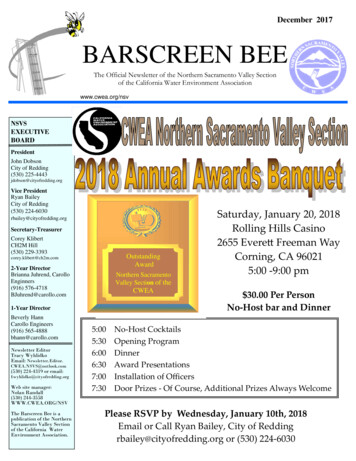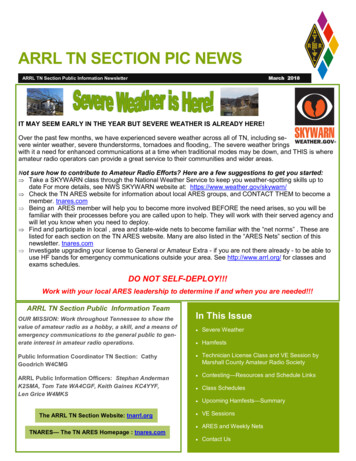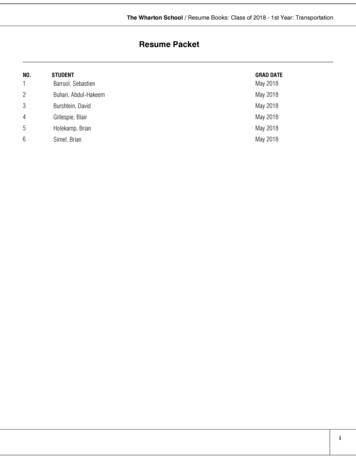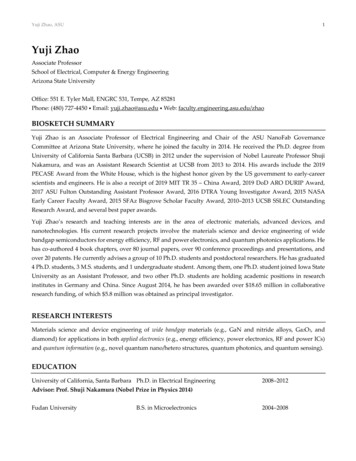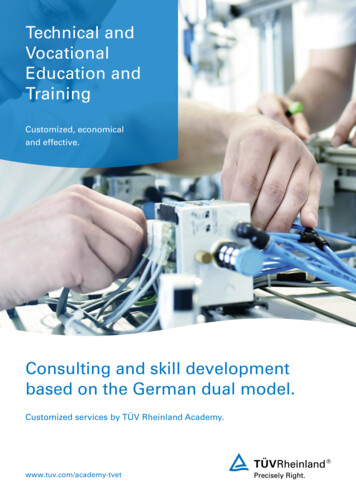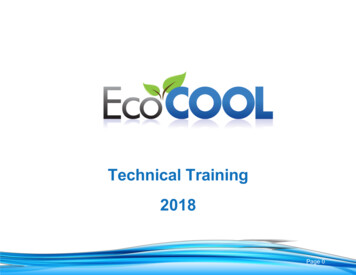
Transcription
Technical Training2018Page 0
Training Agenda IntroductionsEcoCOOL CompositionCompatibilityInstallation VolumesInstallation ToolsEcoCOOL BlendsHVAC and Refrigeration SystemsCompressor SystemsProspect Development ProcessPage 1
EcoCOOL CompositionEcoCOOL is a trade secret. It has been tested by two independent laboratories and neither couldidentify any components that make up EcoCOOL . Even if the components of EcoCOOL wereidentifiable, the blending and baking process of the product cannot be duplicated.American Society of Heating Refrigeration and Air Conditioning EngineersASHRAE states that .5 to 8% of the compressor oil circulates through the coils of an airconditioning or refrigeration system and the oil will form a film of Oil Fouling, which is about 2% ofthe diameter of the tubing.Page 2
EcoCOOL Catalyst #1 – Removes Oil FoulingWhen EcoCOOL is added to the cooling system's compressor oil, catalyst #1 removes the oilfouling by breaking and eliminating the surface tension on the walls of the copper tubing. Theresult is improved heat exchange and increased BTU's. Return air blown over the coils is cooledmore efficiently and provides cooler supply air to the space being cooled. A space that is cooledfaster will satisfy thermostat settings faster and reduce compressor run times. ASHRAE states thatlost energy efficiencies caused by Oil Fouling begin immediately and can be as high as 7% in thefirst year and 5% in the second year; reaching 30% inefficiency and higher, during the life ofequipment.EcoCOOL Catalyst #2 – Makes the Refrigerant Extract Heat More EfficientlyThe #2 catalyst attaches to the hydrocarbon molecule in the refrigerant as it passes through theDirect Expansion Valve. This reaction increases its surface area, and allows for greater heattransfer. The increased heat transfer causes the refrigerant to evaporate more efficiently, reducingwork for the compressor.EcoCOOL Component #3 – Lubricity CompoundThe lubricity compound increases the lubricity of the compressor oil by 54% enabling the theequipment’s moving parts to operate with less vibration, reduced noise levels, lower operatingtemperatures, and reduce friction. These findings have been conducted in an independentlaboratory test by Intertek, using SAE protocols.While we know that EcoCOOL improves mechanical efficiency, it isn’t possible to determinean exact period of extended equipment life. However, improved lubricity can be shown toreduce electricity consumption by 1% to 3%.Page 3
EcoCOOL Compatibility & ApplicationsCompatibility with Refrigerants and Compressor OilsBased on independent Intertek Laboratory reports, using SAE protocols, EcoCOOL is completelycompatible with all modern compressor oils including; traditional mineral oils, and synthetics suchas polyolester (POE) and polyalkylene glycol oils (PAG). Test results in Intertek Laboratory’s haveconfirmed compatibility with all compressor components including gaskets, seals, and metals.Independent Intertek Laboratory reports also confirm that EcoCOOL is compatible with allmodern refrigerants, including:R22 R502 R12 R134a R404a R407c R410a R717 AmmoniaR11 and R123 systems have less oil fouling; therefore, EcoCOOL will not be as effective and isnot used in these systems.R11 has no new production and can only be sourced in recycled refrigerant.R123 will have no new equipment developed from 2020 and no new production for service after2030.Page 4
EcoCOOL Installation VolumesRule #1It is recommended that rule #1 be used only on reciprocating chiller systems and commercialpackaged units. Compressor manufacturer specifications can be found online. A search using thecompressor make, model number, serial number and specifications will usually provide access to auser manual that will list the manufacturer's original compressor oil charge. The necessaryinformation for an online search is found on the label of the compressor.Multiply the oil fill (oil charge) quantity by 10%.For example, if a chiller has eight gallons of oil:8 gallons (multiplied by 128 oz. per gallon) 1024 ounces10% of 1,024 ounces 102 units of EcoCOOL Rule #2Multiply the tonnage by one ounce. This is the acceptable rule for smaller residential DX systems.A 3.5 ton split system will require 3.5 ounces of EcoCOOL . Any system that is less than 2 tons(PTAC units or Aircons) will always require a minimum of 2 units of EcoCOOL .Page 5
EcoCOOL Installation VolumesRule #3When installing EcoCOOL in centrifugal compressors, EcoCOOL Catalyst 1 is installedseparately into the refrigerant circuit at a ratio of .3 ounces per ton. We then install EcoCOOL L(lubricity agent) separately into the oil sump at a ratio of 2% of the manufacturers stated oil charge.Rule #4When installing EcoCOOL in ammonia reciprocating compressors, a pre-blended combination ofEcoCOOL Catalyst 1 and EcoCOOL L is used, and installed at a ratio of 5% of themanufacturers stated oil charge. EcoCOOL is NOT installed in ammonia screw compressors,due to the presence of a coalescing oil separator.Page 6
EcoCOOL Installation ToolsBright Solutions Yellow PumpThis pump is used for non chiller DX systems and automobile installations.Currently, the pump needs to modified for long term use by replacing therubber “O” rings with silicone “O” rings.This pump is recommended for residential installations and light commercialinstalls of less than 16 units. 6-8 full strokes is equal to one unit.The Yellow Jacket Bicycle PumpThis pump is recommended for large chiller installations.The pump will produce 3.5 units per stroke.Pump Care and MaintenanceAfter each day’s use, all pumps must be flushed to maintain purity and avoid Product contamination.Pumps must be flushed with 91% alcohol.Pumps will last longer if silicone “O” rings are installed and they are flushed after each day’s use.Page 7
Refrigerants and EcoCOOL BlendsEcoCOOL standard blend is used in 90% of all applications. There are special blends that areused in certain types of refrigerants and compressors that are noted in the chart below.Model NumberDescriptionEcoCOOL StandardR22/134/410Original EcoCOOL synthetic refrigerant catalyst and lubricity agent.Designed for DX systems – reciprocating, screw and scroll compressors.EcoCOOL Catalyst #1 & #2 onlyEcoCOOL synthetic refrigerant catalyst #1 and #2 with no lubricity compound. Designed forcentrifugal type compressors with DX valve and separate oil circuit.EcoCOOL Catalyst #1 & L (Separately)EcoCOOL synthetic refrigerant catalyst #1 only. Designed for centrifugal compressors with no DXvalve. L (Lubricity Compound) is installed separately, in the oil sump.EcoCOOL Catalyst #1 & L (Combined)EcoCOOL synthetic refrigerant catalyst #1 and L (Lubricity Compound) combined, is pre-blended foruse in Ammonia reciprocating compressors and is installed at 5% of the compressor oil charge.EcoCOOL Catalyst #2EcoCOOL synthetic refrigerant catalyst #2 for specialty installations only.EcoCOOL Lubricity compound L, onlyEcoCOOL lubricity compound. Used only for specialty installations, oil tanks, gear boxes, andrefrigeration systems with separate oil circuit.Page 8
HVAC and Refrigeration SystemsChillersA chiller is a system where water (or glycol or salt water brine) is cooled, not the air. Unlike aircooling, water is used as the heat conductor. Water (brine) or Glycol (antifreeze) is circulated,instead of air, to cool a space or object. Water is cooled in a “barrel” with the evaporatorrefrigeration coils running through it.The cooled or chilled water is pumped to a heat exchanger or“radiator” in the space to be cooled. A fan blows over the radiator,containing the chilled water, which cools the air. The chiller systemis more efficient than an air system since water carries more heatper unit space, than air. The water is cooled to 42 - 48 degrees Fand then returned from the radiator to the chiller barrel for re-cooling.It is returned to the radiator again and again to cool the designatedspace.Chillers can have reciprocating, screw, or centrifugal compressors.For all chiller applications it is critical to confirm the compressor type,refrigerant type, and oil separator type to determine the blend andquantity of EcoCOOL that should be used.Page 9
Compressor SystemsCentrifugal Compressors can contain a separate oil circuitand no DX valve. In this case we add EcoCOOL 1 to therefrigerant circuit at .3 ounces per ton. We separately add thelubricity agent, EcoCOOL L, to the oil circuit at 2% of themanufacturers stated oil charge. It is an industry known factthat oil fouling occurs from oil intruding into the refrigerantcircuit over time through leaky seals. This makes Catalyst 1effective in removing oil fouling. Catalyst 2 reacts as itpasses through the DX valve which is non existent in thesesystems.The original EcoCOOL Blend is compatible with Rotary(screw) compressors provided that there is not a CoalescingOil Separator. Coalescing Oil Separators are generally ahorizontally mounted cylinder. On Rotary (screw)compressors that do not have a coalescing oil separator,Original EcoCOOL Blend is added to the refrigerationcircuit at 10% of the manufacturers stated oil charge.Page 10
Compressor SystemsReciprocating Compressors, that use traditionalrefrigerants, install original blend EcoCOOL at a ratioof 10% of the manufacturers stated oil charge.Semi-Hermetic compressors are housed with the motorin the same housing but the casing is a bolted type andcan be repaired easily. The oil level is monitored by asight gauge and an equal amount of oil should beremoved for the amount of EcoCOOL being installed.EcoCOOL SYNTHETIC CATALYST TECHNOLOGY FORAMMONIA IS FOR AMMONIA DX SYSTEMS ONLY WITHPISTON TYPE COMPRESSORS. EcoCOOL has not beenapproved for use in non DX, or screw, or centrifugal ammoniacompressor systems. EcoCOOL Ammonia Blend is installedat 5% of the manufacturers stated oil charge. It isrecommended to remove 5% of the existing oil charge beforethe EcoCOOL installation.Page 11
HVAC and Refrigeration SystemsRefrigerated Trailer Units (RTU)Refrigerated Trailer Units are attached to trailers or box trucksthat are designed to transport refrigerated products.Usually, the unit uses R134a refrigerant and the compressoris powered by a small diesel engine.The installation volume of EcoCOOL for different sized RTUs:2.5 ton RTU5 ton RTURail Car RTU 8 units of EcoCOOL 12 units of EcoCOOL 16 units of EcoCOOL Page 12
HVAC and Refrigeration SystemsRoof Top Units Scroll CompressorsRoof Top Units (Packaged Units) and most walk-in coolersand freezers will be driven by a reciprocating or scrollcompressor.It is critical to obtain equipment specifications from thecompressor label, not the label of the outside of the PackagedUnit. Some packaged units have multiple compressors, whichcan vary in size.Typically, the compressor oil charge will bestamped on the compressor label.Page 13
HVAC and Refrigeration SystemsPackaged Terminal Air Conditioner (PTAC)A PTAC is a self-contained heating and air conditioning system found inhotels, motels, hospitals, apartment buildings, and sunrooms. PTACs areoften fitted on an external wall, with vents and heat sinks, both inside andoutside of the building. Installing EcoCOOL in PTACs is a unique processbecause these units do not have a service port. A bullet piercing Schradervalve must be soldered onto the refrigerant tubing to enable EcoCOOL tobe installed.Most PTAC units are .75 to 1.5 tons, but both sizes will require a minimum of2 units of EcoCOOL .Residential Split System and Heat PumpsResidential Split Systems have a condensing unit outside the building anda heat exchanger located inside the building. To determine the correct volumeof EcoCOOL to be installed, find the model number on the manufactures labelattached to the outside condenser unit. The model numbers sequence will varydepending on the manufacturer, but the model number will always contain theBTU’s. 12,000 BTU's is equal to one ton. EcoCOOL is installed in residentialsplit systems at a ratio of one unit per ton.For example: Bryant a/c unit Model # 113ANA042000CHA is a 42,000 BTU unit.This equals 3.5 tons and would require 3.5 units of EcoCOOL .Page 14
Compressor SystemsHERMETICALLY SEALLED SCROLL COMPRESSOROriginal Blend EcoCOOL is installed in the low pressureservice port (Schrader valve). We install EcoCOOL inscroll type compressors at a ratio of 10% of themanufacturers stated oil charge.Hermetic type compressors have a completely sealedhousing with its motor also sealed in the same housing.It is leak proof but cannot be repaired. We do not removeany oil when installing EcoCOOL .Page 15
Prospect Development ProcessProof of PerformanceThe following example is a of proof of performance protocol, used by an independent test andbalance engineering firm that specializes in third party data collection and analysis.Testing Protocol for EcoCOOL This testing protocol is provided for the purpose of establishing1. A baseline test for a DX cooling unit to determine the performance of the unit prior to injection ofthe EcoCOOL product.2. Performing the same test to determine the performance on the same unit after the addition ofthe EcoCOOL product. The protocol is as follows:Baseline Testing (Pre EcoCOOL Installation)Measure total airflow being produced by the unit to establish the volume of airflow moving acrossthe DX coil, when possible.Attach data loggers to measure the following metrics and collect data at one minute intervals for aminimum period of 2 weeks. The objective is to establish a range of data that will be used todetermine the baseline performance for the unit:Discharge Air TemperatureSupply Air TemperatureOutdoor Air TemperatureCompressor Motor Amperage (Amperes)Humidity (optional)Page 16
Prospect Development Process (Continued)EcoCOOL Reaction PeriodBecause EcoCOOL is a synthetic catalyst, following installation, a period of time must be allowedfor the catalyst to react with the system. The time allowed for reaction is dependent on the size ofthe system being treated. For the purpose of this example, the reaction period is two weeks.Post EcoCOOL Installation MeasurementAfter the EcoCOOL product has been installed, the data logging of all points will continue, for aminimum period of 2-4 weeks.On completion of the post installation measurement phase, all data will be downloaded from theloggers and submitted to an independent third party, qualified to analyze and prepare reports onthe energy efficiency of HVACR systems. Reports will utilize the collected data to compare theresults of the test unit’s baseline performance, with the unit’s performance following the installationof EcoCOOL .Measurement Protocols For Chilled Water SystemsFor chilled water applications, protocols and timing would be similar, with data collected as follows:Entering water temperature( F)Leaving water temperature( F)Compressor Motor Amperage (Amperes)Chilled water flow through the chiller(GPM)Outdoor Air Temperature( F)The same type of data analysis and results reporting would apply, to chilled water applications.Page 17
Prospect Development Process (Continued)Distributor & Dealer SupportEcoCOOL Technology can provide technical support in all key areas of ProspectDevelopment, including, but not limited to:Selecting equipment for proof of performanceEstablishing objectives and metrics for a proof of performance testLaunching data loggers and downloading test dataPlanning installation optionsProject management oversightIndependent energy expert to analyze test data and prepare a report on performance resultsPage 18
www.ecocoolworld.comPage 19
Packaged Terminal Air Conditioner (PTAC) A PTAC is a self-contained heating and air conditioning system found in hotels, motels, hospitals, apartment buildings, and sunrooms. PTACs are often fitted on an external wall, with vents and heat sinks, both inside and outside of the building. Installing EcoCOOL in PTACs is a unique process

